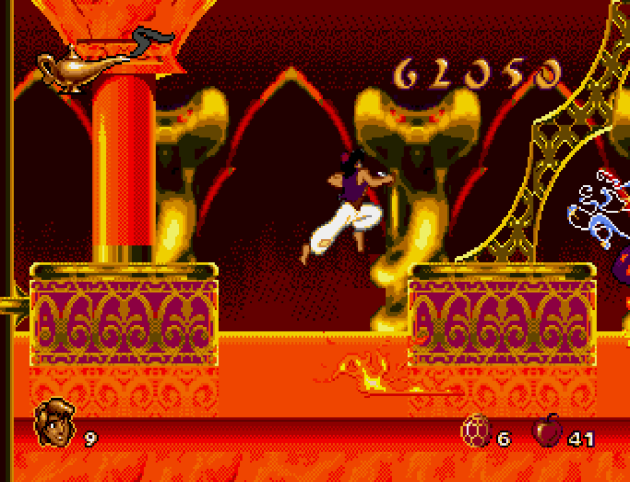Disney’s Aladdin (Sega Genesis Review)
March 2, 2024 1 Comment
 Disney’s Aladdin
Disney’s Aladdin
Platform: Sega Genesis
Developed by Virgin
Published by Sega
First Released November 11, 1993
Included in Disney Classic Games Collection
SPECIAL NOTE: This review is of the FINAL CUT version.
Read the Video Game History Foundation’s article.
If I was told I could only make one change to the Sega version of Aladdin, I think I’d have defeated enemies fall off the screen, like they do in the SNES game. Poofing them out of existence hurts the sword-based combat, which is the defining difference between the two 16-bit versions of Aladdin. I’m a big fan of Capcom’s version, while I’ve never really cared for the Sega Genesis version, and the combat is a big reason why. It’s some of the most inelegant and feathery sword combat I’ve experienced. My father enjoyed the game and told me I was expecting too much, but nuts to that. 2D games could do sword fighting pretty good by this point, and while it’s not Wizards & Warriors levels of bad, it’s nowhere near as swashbuckling as they were aiming for. Unlike the SNES game, apples are lethal in Aladdin for Genesis, so if I was facing a more aggressive enemy, I opted to use them. You also have to use apples to defeat the bosses. In a game that puts such a premium on sword combat, closing with the apples tells me they knew the sword was no good.

The final battle against Jafar is one of the worst in the entire history of 2D gaming. In the first phase, he sucks you in with his magic staff (kinky) and you have to scratch out distance and throw apples. Then, in his final form, you have to stand with the giant snake off-screen to be able to jump up and hit it until it says LEVEL COMPLETE. Oof. Horrible.
In general, I don’t like Virgin’s style of level design. It always has the feel of using a plug-and-play template of platforms and walls to create a zig-zaggy maze from point A to point B. That’s fine if the combat is fun enough to carry the workload, but if it’s not, you’re left with repetitive gameplay and no stand-out set pieces to make up for it. Which isn’t to say there were never moments where I wasn’t enjoying this alternate take on Aladdin. I liked the magic ropes that fly you up to different platforms. I liked the Abu mini-games. And uh.. that’s about it. The fast, flowing action of the SNES game is gone, and instead, Sega’s Aladdin’s level design is so basic, samey, and lacking in set pieces. Even something like hanging from ledges would have helped. Genesis Aladdin never feels spontaneous, which is why it never feels like an Aladdin game.

The escape from the Cave of Wonders scene might as well cut to Dragon’s Lair. The genie’s fingers point where the rock is coming. Well, unless it flashes a “?” and then it’s pure random chance if you live or die.
It’s not like they never got experimental. Actually, this version had better ideas for level themes than the SNES version did. Instead of a stage based around Ancient Egypt, there’s a stage based around Aladdin escaping the dungeon, which sort of happens in the movie. Capcom could have used that for a level and didn’t, and Capcom could have used the magic carpet for the actual platforming levels, another omission that Virgin was wise to include in their game. That said, the similarities are astonishing. Both companies had the same idea about setting the post-Cave of Wonders level inside the lamp. But, whereas the SNES version of this concept is surreal, colorful, and creative, the Genesis version is really drab, cold, and kind of janky. The main platform is this blue substance that’s functionally like quicksand that you sink through if you don’t keep jumping. Granted, I imagine the inside of his lamp would be more like the Genesis version, since it explains why he wouldn’t want to go back to it.

It’s basically magic quicksand. This is a reminder that original ideas aren’t necessarily good ideas.
I don’t really have much more to say about Disney’s Aladdin on the Genesis since I already sort of reviewed it once when I reviewed the original Disney Classics Collection. It’s pretty, I guess, but the much-touted hand drawn animation cost the game weighty combat and accurate collision detection. I’d rather have both those things than “cartoon” animation. Besides, the animation wasn’t on par with the film. It was more like a really cheap Saturday morning cartoon. Cutting edge for 1993, but fated to age badly. Ultimately, it’s just really boring. I have a whole list of Disney games I have to play for this marathon, and the ones I dread most are those by Virgin. Their games are all style and little substance, and certainly nothing worth celebrating. The most frustrating part of their involvement with Sega’s Disney games is that Sega produced one of the all-time greats in Castle of Illusion. Why did they turn to a third party for this, and especially why Virgin of all studios? Apparently it was because Global Gladiators impressed them. So, as with most things in life, blame the most overrated 16 bit game ever made on McDonald’s.
Verdict: NO!

Pingback: Disney’s Aladdin (SNES Review) | Indie Gamer Chick